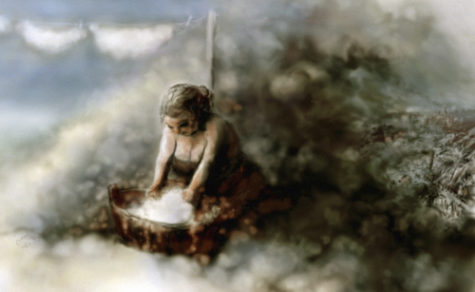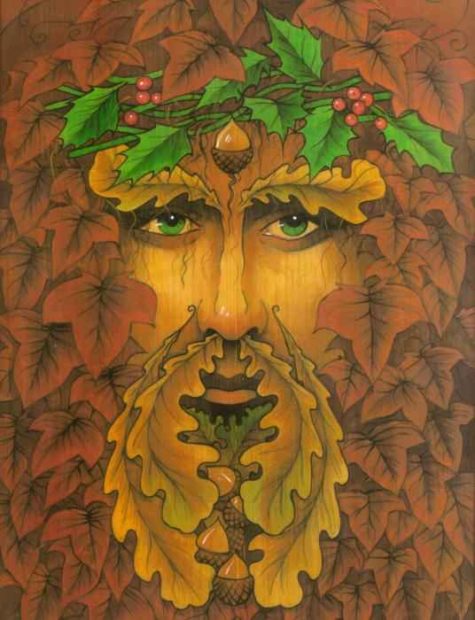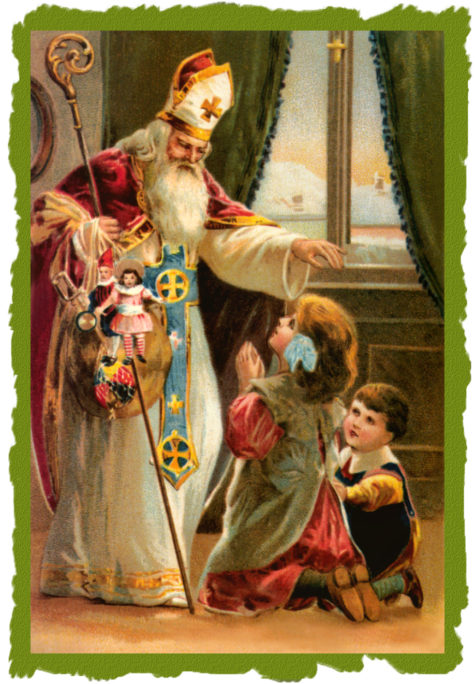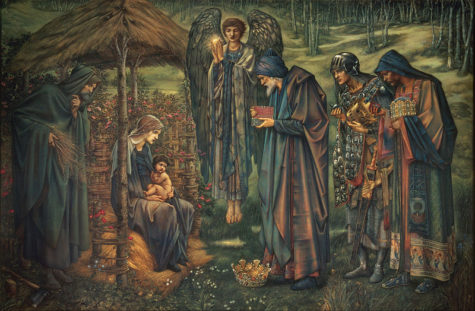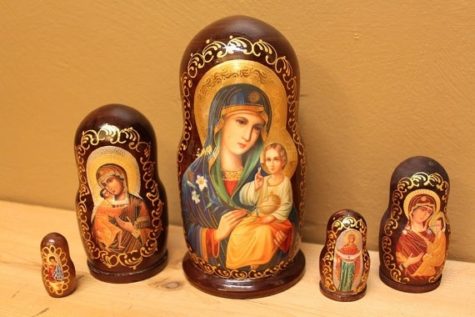Christmas Celebrations
Mother Night is traditionally celebrated on the third day of the twelve days of Christmas. I couldn’t find much lore, but I did find this nice little article in The Winter Solstice about Mother Christmas (Frau Holle, Holda, Hulda, Holla):
Honoring the Mothers
There are so many male figures associated with the Winter Solstice, we should give room to at least one female character, and who better than Mother Christmas? On this day, include a figure of Holda upon your Winter shrine.
Here is a modern invocation for Holda by Diana Paxson:
Holy Holla, in the heavens,
A snowy featherbed you’re shaking –
Bless the earth with your white blanket,
Moist the mantle you are making.
Holla high above come riding.
Your Wagon rolls through winter weather;
Turn away your face of terror,
Bless us as we bide together.
Holy Holla, here we gather,
Send us skill in all our spinning.
Huldrefold (Gnomes) to help in housework,
Wealth and health with your aid winning.
Yule occurs on the Winter Solstice. This is the time of year when the sun is at its lowest point in the sky (Northern Hemisphere) and the Sun enters the sign of Capricorn. This usually happens between December 20th and December 23rd. Also known as: Alban Arthuan, the Winter Solstice marks the longest night of the year.
The word Solstice means “standing-still-sun” because the sun seems to stand still for this one day before the daylight begins to grow again. The sun will only rise higher and higher in the sky from this point onward. It is from this point that the days begin slowly to become longer and longer. The sun is at its most southeastern point over the Tropic of Capricorn in the northern hemisphere and has no apparent northward or southward motion. Since it appears that the sun’s light is growing as each day passes after this one, this holiday is celebrated as the birth of the sun.
The word Yule comes from the Old Norse “iul,” meaning wheel ,and refers to the ‘wheel of the year’, (or the idea of the year, seen as a wheel turning as the seasons change).
To our ancestors, the Sun was often identified with God, and the earth and moon with the Goddess. Since it was at this time that the daylight began to grow, our ancestors believed that this was the day the Goddess gave birth to the ‘sun-Son’. In the time of the ancient tribes this was a time of celebration, for it meant the turning point of winter and the eventual return of spring. Yule is the time when we honor the Goddess for giving birth to the sun once more. It is the time when the Oak King is victorious over the Holly King.
The Holly King represents death and darkness that has ruled since Samhain, and the Oak King represents rebirth and life. The waning (diminishing) sun is overtaken by the waxing (increasing) sun, thus the days become longer after the victory of the Oak King.
Yule is a time when we do Rituals and celebrate the increasing daylight, to renew, and to see the world through the eyes of a child. Spells done at Yule tend to raise our spirits, and bring harmony, peace, and joy. During Yule we see the wisdom of past experience begin to glimmer. The experiences we yielded over the harvest season of the times gone past begin to be reborn as wisdom, new light, to guide us further down the Paths we have chosen.
Because His birth heralds the days growing longer, the God represents hope in the coming cold of Winter and the promise that spring lies ahead. Since we are still in the coldest part of the year, with much cold and darkness still ahead of us, we should emulate the newly born baby. The baby Son draws close to his mother (the Goddess) at this time… we too must draw inward and be thankful for the family we have to help us through the hardships. This is also a time to delve into the depth of your mind and really look at yourself and see what you have learned in the past year.
Yule Traditions and Symbols
It is customary for Witches to decorate the Yule tree, and adorn the house with holly, ivy and pine. It is time when Father Winter, a white bearded chap dress in red, fur trimmed robes, arrives bearing gifts and exchange gifts.
This is the eve when the Yule log from the previous year is burned in the fire. Symbolic of the newborn sun, each year’s Yule log is of oak, charged in a Magic Circle and kept in sacred space the following Yule. This not only celebrates the oak and places it in a place of distinguished honor, but also ensures there will be fuel for the remainder of Winter.
Kissing Under The Mistletoe – Kissing under the mistletoe was first associated with the Greek celebration of Saturnalia and because it was believed to have the power of bestowing fertility, it became associated with marriage rites. In some parts of England, the Christmas mistletoe is burned on the Twelfth Night because it was believed that if it were not burned, all those who had kissed beneath it would never marry. And did you know that originally the custom was that a man should pluck one berry from the mistletoe each time he kisses a woman under the mistletoe, and when the last berry is gone, there should be no more kissing! (Information from Sara Williams)
Leaving Cookies for Santa – The ancient Celtic peoples left offerings of seeds, oats and oatcakes for the “wee people” and for the Gods or Goddesses of the different tribes. This practice evolved into the modern practice of leaving milk and cookies for Santa Claus.
Decorating The Yule Tree – In ancient times, the tree was decorated with symbols of the gifts the people wanted to receive from the Gods… Acorns, Oak Leaves, and Suns were representations of the Sun God. Birds and Bird Nests represented fertility as well as the return of the migrating flocks of birds in the Spring. Candles (and later, lights) were used to welcome back the Sun God and to encourage the sun to return. Crescent Moons and Silver Balls represented the Mother Goddess in her many forms Flowers, even the Poinsettia, represented the hope of the coming or Spring. Frogs, particularly Tree Frogs were for calling Spring back, since the call of the tree frog is one of the earliest signs of Spring. Fruit represented a bountiful harvest as well as the coming season of renewal and birth. Harps represented the continuity handed down by traveling Bards. Horns, drums and other musical instruments symbolized the ‘Blowing in the Yule’ and also represented the joyous music that welcomes the Sun God. Nuts represented a bountiful harvest. Toads, especially when hung upside down, were considered strong protection for the family.
Bells – Ancient Pagans rang bells during the Winter Solstice festivities to drive away demons that surfaced during the dark time of the year.* Also, the ringing of bells was thought to chase away the darkness so in some cultures, bells were rung in the morning as everyone rose to chase away the darkened days bring and heralding the warmer days.
Candles – Fires have been lit since ancient times to ward off the chill of Winter, chase away demons, and lure back the returning Sun (or son). * Candles were a useful way to have an ‘eternal’ flame while in the home. Also, many more candles could be lit than fires meaning more encouragement for the returning Sun.
Candy Cane – There is no denying that the Candy Cane has Christian roots… After all, an ingenious candy maker took an already existing candy – a straight white peppermint candy and bent the end of it to resemble a shepherd’s crook – since Jesus was the shepherd of men… or the letter “J”, for Jesus. He then placed a wide red stripe was to represent the blood Jesus shed on the cross, the three small red stripes were to represent his scourging, and the white of the cane was to represent the purity of Jesus and/or the forgiveness of sins his suffering bought for mankind.
However, Pagans have their own symbolism for the candy cane… The colors represent the God and Goddess (either as Red for the heat of the Sun and white for the coolness of the moon OR as Red for the blood shed by the mother while giving birth to the Sun God and white for the brightness of the Sun). The colors also represent the balance of the God and Goddess (or nature) since neither color is more prominent than the other color is. The peppermint is cool on the tongue (symbolizing the chill of winter), but has a bite to it, which is symbolic of the heat of the reborn Sun.
Elves – Elves first became associated with Yule because the ancients knew that the Spirits that created the Sun inhabited the land of Elves. By including elves in the Yule celebrations, the ancients believed they were assuring the elves assistance in the coercion of the Sun to return. Of course, since Father Christmas was patterned very closely after Odin, who was the King of the Elves, it makes sense that elves would be associated with him (and Christmas) also.
Evergreens – Evergreens were thought to have power over death because their green never faded. The evergreens were considered to be so powerful that they could defeat winter demons and hold back death and destruction. Because of their power and tenacity, evergreens were also believed to encourage the Sun’s return and were therefore placed around the home, both inside and out.
Gingerbread – Gingerbread was considered to be a specialty bread since ginger hadn’t ever been available until the Crusaders brought it back in the 11th century. There were strict laws regarding specialty breads in that time, so gingerbread was only allowed to be produced during Easter and Christmas. Since there was no Easter marketplace, it wasn’t long before gingerbread became associated with winter and Christmas.
Holly – The evergreen of the Holly leaves represents the hope of winter survival in celebrations of the winter solstice throughout the Old World. It is also, of course, representative of the Holly King (Father Christmas). The British consider the thorny-leafed holly to be male and the smooth-leafed holly to be female. Because of this, whichever variety is first brought into the home during the holidays determines which gender will lead the household during the coming year.
Mistletoe – The word ‘Mistletoe’ translates from its Anglo-Saxon origin into ‘dung-on-a-twig’. It came by this name because the ancient peoples observed that mistletoe would often appear on a branch or twig where birds had left droppings. (It was later discovered – in the sixteenth century – that the mistletoe seeds had been eaten by the birds and then sprouted after passing through the digestive tract and being deposited in the droppings). The mistletoe of the sacred oak was especially sacred to the ancient Celtic Druids and would be harvested on the sixth night of the moon with a golden sickle. Since it was gathered at Winter Solstice and it was seen as the ‘soul’ of the oak (and as a sexual symbol), the cutting of the mistletoe came to symbolize the defeat of the Oak King by the Holly King. It was hung from ceilings and place over doorways to ward off evil spirits (and to prevent witches from entering). (Information from Sara Williams)
Reindeer – Many people believe that reindeer are symbolic of the stags that drew Freya’s chariot. Of course, there is always the theory that there are 8 reindeer to represent the eight-legged steed of Odin (or the 8 Sabbats). Either way, it is easy to extrapolate that reindeer are a symbol of Cernunnos and that having horned creatures as a symbol of the day the Sun God is reborn is only fitting.
Santa Claus – Today’s Santa is a folk figure with multicultural roots. He embodies characteristics of Saturn (Roman agricultural god), Cronos (Greek god, also known as Father Time), the Holly King (Celtic god of the dying year), Father Ice/Grandfather Frost (Russian winter god), Thor (Norse sky god who rides the sky in a chariot drawn by goats), Odin/Wotan (Scandinavian/Teutonic All-Father who rides the sky on an eight-legged horse), Frey (Norse fertility god), and the Tomte (a Norse Land Spirit known for giving gifts to children at this time of year). Santa’s reindeer can be viewed as forms of Herne, the Celtic Horned God. Decorate your home with Santa images that reflect His Pagan heritage. Information from Selena Fox.
Tinsel – The tradition of placing tinsel on the tree comes from an old legend. Apparently, spiders were not allowed near the Yule tree – not even close enough to get a peek of it. Needless to say, this upset them greatly, so they complained. In some versions of the story they complain to the Christ-child, in others, they complain to the Goddess… either way, they were allowed admittance to the tree. Overjoyed by their victory, the spiders climbed around the tree, wrapping it in glistening webs. The Christ-child (or Goddess, depending on the story) was so delighted by their creativity that the webs were transformed into strands of silver (i.e. tinsel).
Tree – The custom of having a tree as a central focal piece in winter holiday celebrations can be traced back hundreds of centuries. The ancient Egyptians had a custom of bringing branches from palm trees into their homes on the shortest day of the year each December. The Chinese and Hebrews from ancient history had similar traditions, too.
Wassail – Wassail comes from the Old English words waes hael, which means “be well,” “be hale,” or “good health.” A strong, hot drink (usually a mixture of ale, honey, and spices) would be put in a large bowl, and the host would lift it and greet his companions with “waes hael,” to which they would reply “drinc hael,” which meant “drink and be well.” However, the ritual of ‘wassailing’ consisted of saluting the fruit trees and then sprinkling them with a bit of the wassail drink (which consisted of wine, ale, or cider with apples and eggs blended in)
Wreaths – The wreath’s circle symbolizes the wheel of the year and the completion of another cycle. Wreaths are hung as decoration and given as gifts to symbolize the infinity of goodwill, friendship, and joyfulness.
Yule Log – The custom of burning the Yule log began with the ancient Scandinavians who burned a huge log in honor of their god Thor once a year. For the Vikings, the yule log was an integral part of their celebration of the solstice, the julfest; on the log they would carve runes representing unwanted traits (such as ill fortune or poor honor) that they wanted the gods to take from them. Even as the Christian religion filtered into Scandinavia, the custom of the Yule log remained. The log was thought to bring blessings if it lasted 24 hours. It was also thought that the longer the Yule log burned the faster the Sun would come to warm the earth. Individuals would keep an unburned part of the log to light the next year’s Yule log. This unburned portion was also thought to bring good luck as well as protect the home from lightning and fire during the year.
Spell craft of Yule:
Spell craft performed for Yule should be for peace, harmony, love, and increased happiness.
Activities for Yule:
Caroling, wassailing , burning the Yule log, decorating the Yule tree, exchanging of presents, kissing under the mistletoe, feeding of animals and/or birds with grains and seeds
The God of Yule:
Frey – God, brother-consort of Freyja; son of Njord. “The Lord”, fertility and creativity God; “the Lover”; God of Yule. He is the god of wealth and peace and contentment. Blood was not allowed to be spilled through violence, nor where weapons or outlaws allowed on or in his holy places.
Other Deities:
- Apollo, Brighid, Demeter, Diana, Divine Child, Gaea, Great Mother, Green Man, Isis, Lugh, Mabon, Oak King, Odin, Ra, The Horned One
Symbols:
- A simmering pot of wassail, Baskets of clove studded fruit, Christmas cactus, Evergreen boughs or wreaths, Gold pillar candles, Holly, Mistletoe hung in doorways, Poinsettias, Yule log, or small Yule log with 3 candles
Herbs of Yule:
- Mistletoe: Magical Uses – Use to combat despair, herb of protection, child theft by fairies, healing, hunting, conception, to bring beautiful dreams, unlock the secrets of immortality through dreams – used for wands and ritual items or placed around a ‘Hand of Glory’ to ward off thieves – to protect the bearer from werewolves.
- Holly: Symbolizing – Protection; Good Luck. Forms used include boughs over portals, wreaths
- More Herbs: Bayberry, blessed thistle, laurel, pine, sage, yellow cedar, Bayberry. Blessed thistle, Evergreen, Frankincense, Holly, Laurel, Mistletoe, Oak, Pine, Sage, Yellow cedar.
Foods of Yule:
- Cookies and caraway cakes soaked in cider, Eggnog, Fruits, Ginger tea, Nuts, Pork dishes, Spiced cider, Turkey, Wassail, or lamb’s wool (ale, sugar, nutmeg, roasted apples).
Incense of Yule:
- Bayberry, Cedar, Cinnamon, Pine,
Colors of Yule:
- Green, Red, White, Gold, Silver, Yellow, Orange
Stones of Yule:
- Diamonds, Rubies, Emeralds, Bloodstones, Garnets
Trees for Yule:
- Oak : Endurance, Strength, Triumph, Protection. Magical Uses – Abundance, fertility, longevity, protection, spiritual awareness while remaining fully rooted in the earth plane, it’s wood is used for staves and wands, use any parts for protective charms which bring healing. Acorns bring fertility and abundance. Plant in the dark of the moon to bring financial prosperity.
- Evergreens: Continuity of Life, Protection, Prosperity. Forms used include boughs, wreaths, garlands, trees.
- Yew : Last Day of Solar Year; Death
- Silver Fir: Winter Solstice Day; Birth.
- Birch: Month following Winter Solstice; Beginnings.
From: Mystic Moon Coven and other sources
Many countries in Europe celebrate the Feast of Sinterklaas, or St. Nicholas, on the eve of December 6. After dinner, families hunt for their presents, following clues in funny, anonymous poems. They also eat candies and cookies, especially spicy crispy ginger-cookie figures formed in a traditional wooden mold.
The legend of St. Nicholas is, like the lives of many saints, shrouded in mystery. We know that he was the bishop of Myra in Lycia, part of Asia Minor, during the fourth century. He is credited with saving three sisters from lives of ill repute by throwing bags of gold into their house (some say down the chimney, others say through the window) to provide for their dowries.
In many places in the United States and abroad, children still hang their stockings by the chimney or place their shoes by the window for St. Nicholas to fill them with presents and sweets on the eve of his feast day. He is considered the patron saint of children.
Source: Almanac.com
Advent is a season observed in many Western Christian churches as a time of expectant waiting and preparation for the celebration of the Nativity of Jesus at Christmas. The term is a version of the Latin word meaning “coming”.
It is unknown when the period of preparation for Christmas that is now called Advent first began – it was certainly in existence from about 480 – and the novelty introduced by the Council of Tours of 567 was to order monks to fast every day in the month of December until Christmas. Some have even said it goes back to the time of the Twelve Apostles or that it was founded by Saint Peter himself. This has led to the conclusion that it is “impossible to claim with confidence a credible explanation of the origin of Advent”.
For Christians, the season of Advent anticipates the coming of Christ from three different perspectives. “Since the time of Bernard of Clairvaux (d.1153) Christians have spoken of the three comings of Christ: in the flesh in Bethlehem, in our hearts daily, and in glory at the end of time.” The season offers the opportunity to share in the ancient longing for the coming of the Messiah, and to be alert for his Second Coming.
Advent is the beginning of the Western liturgical year and commences on the fourth Sunday before Christmas, the Sunday nearest to St. Andrew’s Day (30 November), in the Roman Rite of the Catholic Church, and in the Anglican, Lutheran, Moravian, Presbyterian and Methodist calendars. In the Ambrosian Rite and the Mozarabic Rite of the Catholic Church, Advent begins on the sixth Sunday before Christmas, the Sunday after St. Martin’s Day (Nov 11).
Practices associated with Advent include keeping an Advent calendar, lighting an Advent wreath, praying an Advent daily devotional, as well as other ways of preparing for Christmas, such as setting up Christmas decorations, a custom that is sometimes done liturgically, through a hanging of the greens ceremony.
The equivalent of Advent in Eastern Christianity is called the Nativity Fast, but it differs in length and observances, and does not begin the liturgical church year as it does in the West. The Eastern Nativity Fast does not use the equivalent parousia in its preparatory services.
Folk traditions:
In England, especially in the northern counties, there was a custom (now extinct) for poor women to carry around the “Advent Images”, two dolls dressed to represent Jesus and the Blessed Virgin Mary. A halfpenny coin was expected from every one to whom these were exhibited and bad luck was thought to menace the household not visited by the doll-bearers before Christmas Eve at the latest.
In Normandy, farmers employed children under twelve to run through the fields and orchards armed with torches, setting fire to bundles of straw, and thus it was believed driving out such vermin as were likely to damage the crops.
In Italy, among other Advent celebrations is the entry into Rome in the last days of Advent of the Calabrian pifferari, or bagpipe players, who play before the shrines of Mary, the mother of Jesus: in Italian tradition, the shepherds played these pipes when they came to the manger at Bethlehem to pay homage to the infant Jesus.
In recent times the most common observance of Advent outside church circles has been the keeping of an advent calendar or advent candle, with one door being opened in the calendar, or one section of the candle being burned, on each day in December leading up to Christmas Eve. In many countries, the first day of Advent often heralds the start of the Christmas season, with many people opting to erect their Christmas trees and Christmas decorations on or immediately before Advent Sunday.
Colors of Advent:
The usual liturgical color in Western Christianity for Advent is either violet (or purple) or blue. The violet or purple color is often used for hangings around the church, the vestments of the clergy, and often also the tabernacle. In some Christian denominations, blue, a color representing hope, is an alternative liturgical color for Advent, a custom traced to the usage of the Church of Sweden (Lutheran) and the medieval Sarum Rite in England.
The Lutheran Book of Worship lists blue as the preferred color for Advent while the Methodist Book of Worship and the Presbyterian Book of Common Worship identify purple or blue as appropriate for Advent. There has been an increasing trend in Protestant churches to supplant purple with blue.
Proponents of this new liturgical trend argue that purple is traditionally associated with solemnity and somberness, which is fitting to the repentant character of Lent. The Roman Catholic Church retains the traditional violet.
On the 3rd Sunday of Advent, Gaudete Sunday, rose may be used instead, referencing the rose used on Laetare Sunday, the 4th Sunday of Lent. During the Nativity Fast, red is used by Eastern Christianity, although gold is an alternative color.
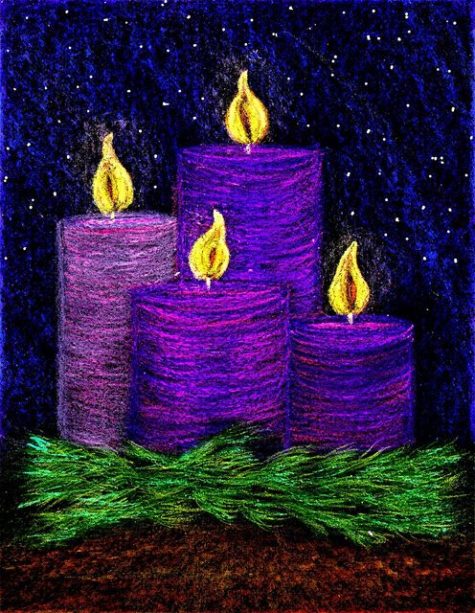 Four Sundays and Four Candles:
Four Sundays and Four Candles:
The keeping of an advent wreath is also a common practice in homes or churches. The readings for the first Sunday in Advent relate to the old testament patriarchs who were Christ’s ancestors, so some call the first advent candle that of hope.
The readings for the second Sunday concern Christ’s birth in a manger and other prophecies, so the candle may be called of Bethlehem, the way or of the prophets.
The third Sunday, Gaudete Sunday after the first word of the introit (Philippians 4:4), is celebrated with rose-colored vestments similar to Laetare Sunday at the middle point of Lent. The readings relate to St. John the Baptist, and the rose candle may be called of joy or of the shepherds.
In the Episcopal Church USA, the collect stir up may be read during this week, although before the 1979 revision of the Book of Common Prayer it was sometimes read in the first Sunday of Advent. Even earlier, ‘Stir-up Sunday’ was once jocularly associated with the stirring of the Christmas mincement, begun before Advent. The phrase ‘Stir up’ occurs at the start of the collect for the last Sunday before Advent in the 1662 Book of Common Prayer.
The readings for the fourth Sunday relate to the annunciation of Christ’s birth, so the candle may be known as the Angel’s candle. The Magnificat or Song of Mary may be featured.
Where an advent wreath includes a fifth candle, it is known as the Christ candle and lit during the Christmas Eve service.
Source: Wikipedia
